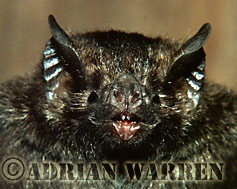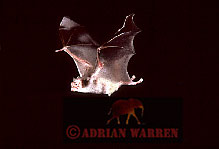But this control method was not having a significant effect, so they tried a more lethal technique. The bats were caught in mist nets as they flew in to attack the farm animals; once one of the control team had removed a bat carefully from the net, another smeared petroleum jelly impregnated with poison on to its fur. The bat was then released to fly back to its roost. There, it begins to lick itself clean and so swallows the poison. Its companions, which always keep themselves so well groomed, come to help it clean up. So the poison spreads through the entire colony. The poison causes an internal haemorrhage and only a small amount is needed to cause death; it is estimated that for every bat caught, treated and released, as many as 20 others may die. The next day we visited the cave; of the 60 or so vampires we filmed only a few remained alive. The carcasses of the others littered the cave floor. We watched as the team collected the bodies and placed them in plastic bags; if they did not do so some innocent scavenging animal might have come to feast on the dead bats and also die of the poison. It was a control method frightening in its efficiency, but although humans are eliminating roosts around inhabited areas, small remote colonies in the forest continue to flourish. The fact is that before Europeans colonized South America and brought their cattle, horses and chickens, vampire roosts were probably far less numerous than they are today. Domestic stocks are easy prey for vampires and allowed them to flourish to an almost unlimited extent. In the natural state, vampires were probably few and far between, feeding on monkeys, peccaries, tapirs, anteaters and the larger game birds such as curassows. The vampire's way of life could be called a marvel of evolutionary specialization; it has few enemies, it does not tear its living prey to pieces like many of the carnivores we admire so much. Indeed, it lives with great economic efficiency, only rarely killing its hosts; and were it not for the fact that, like our own much loved dogs, it occasionally carries rabies, it could justly be called relatively harmless. But the name it has inherited means that in the eyes of most people this little, meticulously clean creature is doomed for ever to be loathed as a supernatural harbinger of death.
|
(Approx. 3050 words) ©ADRIAN WARREN 1979 Desmodus in flight |


